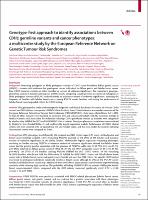| dc.contributor | Vall d'Hebron Barcelona Hospital Campus |
| dc.contributor.author | García-Peláez, José |
| dc.contributor.author | Matos, Rita |
| dc.contributor.author | Lobo, Silvana |
| dc.contributor.author | Dias, Alexandre |
| dc.contributor.author | Garrido, Luzia |
| dc.contributor.author | Castedo, Sergio |
| dc.contributor.author | Balmaña, Judith |
| dc.date.accessioned | 2023-05-12T11:31:45Z |
| dc.date.available | 2023-05-12T11:31:45Z |
| dc.date.issued | 2023-01 |
| dc.identifier.citation | Garcia-Pelaez J, Barbosa-Matos R, Lobo S, Dias A, Garrido L, Castedo S, et al. Genotype-first approach to identify associations between CDH1 germline variants and cancer phenotypes: a multicentre study by the European Reference Network on Genetic Tumour Risk Syndromes. Lancet Oncol. 2023 Jan;24(1):91–106. |
| dc.identifier.issn | 1474-5488 |
| dc.identifier.uri | https://hdl.handle.net/11351/9526 |
| dc.description | Genotip; Fenotips del càncer; Tumor genètic |
| dc.description.sponsorship | European Reference Network on Genetic Tumour Risk Syndromes, European Regional Development Fund, Fundação para a Ciência e a Tecnologia (Portugal), Cancer Research UK, and European Union's Horizon 2020 research and innovation programme. |
| dc.language.iso | eng |
| dc.publisher | Elsevier |
| dc.relation.ispartofseries | The Lancet Oncology;24(1) |
| dc.rights | Attribution-NonCommercial-NoDerivatives 4.0 International |
| dc.rights.uri | http://creativecommons.org/licenses/by-nc-nd/4.0/ |
| dc.source | Scientia |
| dc.subject | Mama - Càncer - Aspectes genètics |
| dc.subject | Aparell digestiu - Càncer - Aspectes genètics |
| dc.subject | Genotip |
| dc.subject.mesh | Breast Neoplasms |
| dc.subject.mesh | Stomach Neoplasms |
| dc.subject.mesh | Genetic Predisposition to Disease |
| dc.title | Genotype-first approach to identify associations between CDH1 germline variants and cancer phenotypes: a multicentre study by the European Reference Network on Genetic Tumour Risk Syndromes |
| dc.type | info:eu-repo/semantics/article |
| dc.identifier.doi | 10.1016/S1470-2045(22)00643-X |
| dc.subject.decs | enfermedades de la mama |
| dc.subject.decs | neoplasias gástricas |
| dc.subject.decs | predisposición genética a la enfermedad |
| dc.relation.publishversion | https://doi.org/10.1016/S1470-2045(22)00643-X |
| dc.type.version | info:eu-repo/semantics/publishedVersion |
| dc.audience | Professionals |
| dc.contributor.organismes | Institut Català de la Salut |
| dc.contributor.authoraffiliation | [Garcia-Pelaez J] Instituto de Investigação e Inovação em Saúde (i3S), University of Porto, Porto, Portugal. Faculty of Medicine, University of Porto, Porto, Portugal. Instituto de Patologia e Imunologia Molecular da Universidade do Porto, Porto, Portugal. Porto Comprehensive Cancer Center Raquel Seruca, Porto, Portugal. [Barbosa-Matos R, Lobo S] Instituto de Investigação e Inovação em Saúde (i3S), University of Porto, Porto, Portugal. Institute of Biomedical Sciences Abel Salazar, University of Porto, Porto, Portugal. Instituto de Patologia e Imunologia Molecular da Universidade do Porto, Porto, Portugal. Porto Comprehensive Cancer Center Raquel Seruca, Porto, Portugal. [Dias A] Instituto de Investigação e Inovação em Saúde (i3S), University of Porto, Porto, Portugal. Instituto de Patologia e Imunologia Molecular da Universidade do Porto, Porto, Portugal. Porto Comprehensive Cancer Center Raquel Seruca, Porto, Portugal. [Garrido L] Centro Hospitalar Universitário São João, Porto, Portugal. [Castedo S] Instituto de Investigação e Inovação em Saúde (i3S), University of Porto, Porto, Portugal. Faculty of Medicine, University of Porto, Porto, Portugal. Instituto de Patologia e Imunologia Molecular da Universidade do Porto, Porto, Portugal. Centro Hospitalar Universitário São João, Porto, Portugal. Porto Comprehensive Cancer Center Raquel Seruca, Porto, Portugal. European Reference Network on Genetic Tumour Risk Syndromes (ERN GENTURIS), Porto, Portugal. [Balmaña J] Vall d'Hebron Hospital Universitari, Barcelona, Spain. Universitat Autònoma de Barcelona, Bellaterra, Spain. ERN GENTURIS, Barcelona, Spain |
| dc.identifier.pmid | 36436516 |
| dc.identifier.wos | 000928248100001 |
| dc.rights.accessrights | info:eu-repo/semantics/openAccess |


